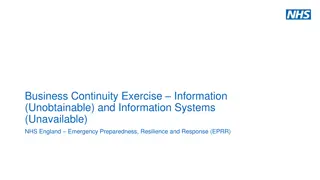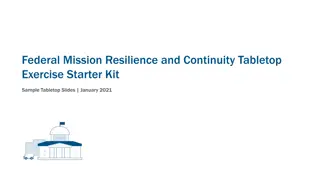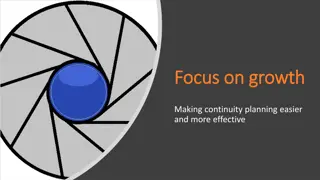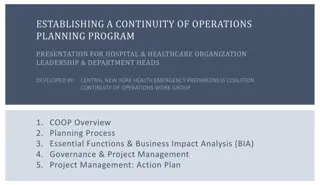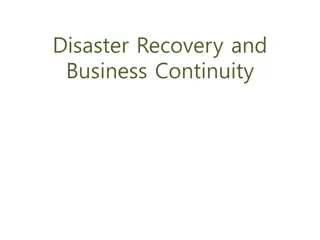Academic Continuity Planning - Critical Functions and Importance
Academic Continuity Planning (ACP) is vital for ensuring the provision of mission-critical services in higher education. It involves preparing for disruptive events to reduce their impact and swiftly restart essential functions. This plan is essential for complying with regulations, maintaining service continuity, and safeguarding the institution's core operations.
Download Presentation

Please find below an Image/Link to download the presentation.
The content on the website is provided AS IS for your information and personal use only. It may not be sold, licensed, or shared on other websites without obtaining consent from the author.If you encounter any issues during the download, it is possible that the publisher has removed the file from their server.
You are allowed to download the files provided on this website for personal or commercial use, subject to the condition that they are used lawfully. All files are the property of their respective owners.
The content on the website is provided AS IS for your information and personal use only. It may not be sold, licensed, or shared on other websites without obtaining consent from the author.
E N D
Presentation Transcript
Limited Production Meets a Wave of Demand After benefiting from one of the best years (2020) for boat sales, manufacturers and dealers experienced the same supply-chain issues and limited inventory as the RV, motorsports and automobile markets. Americans, however, were still escaping to the outdoors during the pandemic and boating was one of their top choices. The table on page 1 of the Profiler shows Americans 2021 spending for pleasure boats exceeded 2020 and 2019. According to Statistical Surveys, which publishes monthly marine industry sales data, production has improved. Every newly-manufactured boat is already sold and more inventory should be available for the annual peak season during May and the summer.
Good, But Stalled Boat Sales The National Marine Manufacturers Association (NMMA) estimates more than 300,000 new powerboats were sold during 2021, which was only the second year of the past 15 exceeding that total; however, that would be 4% to 6% fewer units than 2021. Statistical Surveys reported total 2021 sales of 288,203 units, a 6.0% YOY decrease, but that represents 60.44% of the total industry. November and December s YOY performances at +0.1 and -4.0%, were a significant improvement from October s -19.9% YOY decrease. 2021 sales decreased for all categories in the powerboat segment, except semi-custom yachts, with outboard (bowrider/ deck) decreasing the most at 21.1%. Among other categories personal watercraft (PWC), the largest, increased just 0.3%.
Dealers Becalmed with Little Inventory In the Marine Retailers Association of the Americas (MRAA)/Robert W. Baird/Soundings Trade Only December 2021 Marine Retailer Pulse Report, 91% of dealers said their new boat inventory was too low and 85% said the same of their used boat inventory. Of seven demand factors, dealers said the strength of the US economy had the most positive effect, but new products and government action/inaction had the most negative effect, with trade-in activity and OEM promotions also stifling demand. A summer 2021 MRAA dealer survey found 71.5% of dealers said parts availability was their biggest obstacle to completing customers boat repairs and 73.5% said parts availability was the biggest reason they required more time to return boats to customers.
Boaters Take to the Water Data analysis of five 2021 representative consumer/market surveys (summer and fall) conducted by The Media Audit reveals 7.2% of all households own a power or motorboat and 1.1% own a sailboat. The average age of adults 18+ living in a household that owns a power or motorboat was 43.3 and their average income was $79,900. Gen Zers over-indexed the most living in these households at 139, indicating strong ownership in families with teenagers and young adults. The average age of adults 18+ living in a household that owns a sailboat was 40.7 and their average income was $68,100. Although Baby Boomers and Gen Zers over- indexed at 136 and 132, respectively, Millennials over- indexed the most at 144.
Boating Is a Family Activity A different set of data from The Media Audit s same five consumer/market surveys reveals households with any children at home and 6 12 and 13 17 of age over-indexed, on average, for boat ownership, or 128, 140 and 137, respectively. The average indices are even larger for some age groups in these households that have been boating or sailing during the past four weeks: children at home any age at 126, children younger than 6 at 117, children 6 12 at 151 and 13 17 at 174. Working or not working from home is another interesting comparison. Those adults 18+ who work from 3 to 4 days per week over-indexed the most, on average, at 166 compared to those who are employed full-time and don t work from home at an average of 143.
Upbeat for 2022 The NMMA is forecasting as much as a 3% increase for 2022 boat sales compared to 2021. A 2022 Boating Industry dealer survey found 30.7% said their 2022 sales would increase by less than 10% and another 25.8% said by 10% to 25%. Despite that optimism, two-thirds (66.7%) of the dealers said they think it will be 2023 before manufacturing and available inventory will be able to satisfy consumer demand. On a scale of 1 to 5, the dealers said affordability at 4.3 was the biggest challenge for the industry, with labor issues second at 4.2 and customer experience fourth at 3.9.
Advertising Strategies Media salespeople can familiarize themselves with Discover Boating s 2022 promotional campaign, See You Out There, and help local dealers to maximize their use of the campaign with targeted media buys and messages. A combination of TV and direct mail is another excellent strategy to reach Millennials. Use plenty of photos of people enjoying their boats and the water and include a section explaining boating basics. Promote a Let Us Take You Boating contest. Consumers and customers considering a purchase can enter to win a weekend afternoon on the water with a dealer consultant that includes the cost of a boat rental and an onboard picnic.
New Media Strategies Most of the new, first-time boaters are younger adults. Dealers can post short videos on social media with basic boating tips as well as suggestions for where to boat in the region and activities that can be enjoyed on a boat. With tight inventory to continue throughout 2022, dealers can use social media to share the latest inventory trends because many consumers now insist on that transparency. Promote pre-ordering so more consumers will have their new boat during the season.


